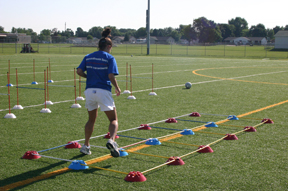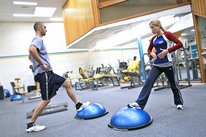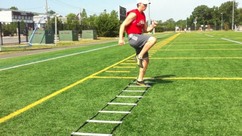
© Ennis Physiotherapy Clinic, 3A Barrack Close, Barrack Street, Ennis, Co. Clare V95 X437 Tel: (065) 6840757
Spinal Problems Neck + Back Pain Disc Injury Whiplash Posture
Lower Limb Injuries Walking + Running Ligament Injury Snowsports Injury Home Exs Prog
Upper Limb Injuries Ligament Sprains Tendon+Muscle Golf + Bike Set Up Useful Links




065 6840757

Mon - Fri 9.30am - 8.30pm


3a Barrack Close, Barrack St., Ennis, Co. Clare V95 X437
Muscle Energetic's Ideal Body Weight
Strength Training Safe Weight Gain/ Bulk Up
Muscle Power Training Muscle Endurance Training
Muscle cells use ATP (Adenosine Triphosphate) molecules as the source of energy for muscle
work. Complex biochemical actions by enzymes release energy from ATP to produce ADP
(Adenosine Diphosphate) and a separate P (phosphate).
The mechanisms for achieving this occur using oxygen (O2) during Aerobic exercise or has to
occur without oxygen, which is Anaerobic exercise. Aerobic exercise is the preferred and more
efficient exercise. Aerobic processes can produce enough energy (the ATP) with normal activity
but intense exercise (Sprinting flat out) can cause the demand for ATP to outstrip thee supply ATP
energy produced by aerobic means. This will lead to the body using anaerobic means to produce
the additional ATP energy (which is not as efficient) to keep up with demand.
If the intense exercise is sustained the systems will not be able to keep up with the demand and
fatigue becomes more and more pronounced until eventually the exercise intensity can no longer be
Sustained.
As the intensity of exercise is reduced due to fatigue the system can gradually get back to meeting
the demand with aerobic exercise.
Energy can be released immediately using a phosphocreatine system but this is very short lived
Energy is then progressively released from the anaerobic and aerobic systems, with the latter being
the most efficient at producing energy over a prolonged period of exercises.
With prolonged periods of exercise the liver stores of glycogen and fatty acids can be mobilised
after muscle glycogen has been depleted.
Intensity of exercise is very important in determining the demand for energy / ATP and from where /
how this energy demand is met.
Exercise at an intensity equivalent to 65% of VO2max is the intensity that will use the most energy
sourced from fat. Therefore if weight loss is the key purpose or aim in an exercise programme
selecting the correct intensity for the exercise, and sustaining it over an appropriate period of time is
essential.
Once the intensity of the exercise exceeds that where the aerobic systems can meet the demand for
energy / ATP, any further demand for ATP must be met by increased use of the anaerobic systems.
Acidity within the muscle varies with intensity of exercise. Normal PH levels within muscle is
approx 7.1. After starting exercise there is an initial increase in alkalinity due to the effects of the
instant energy (phosphocreatine) system being used. At lower intensity of exercise amount of
lactic acid produced equals or is less than than being removed and so there is no build up within the
muscles + bloodstream. At higher intensities the production of lactic acid exceeds the amount being
removed and therefore there is a steady rise in acidity within the muscle and of lactate within the blood.
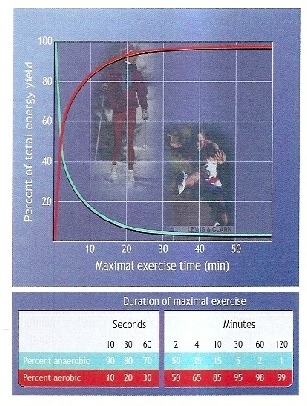 Accumulated lactic acid / lactate within the leads to muscle soreness and stiffness following exercise. Steady low intensity exercise is essential therefore as part of a warm down to reduce the levels of lactic acid (lactate) in the muscles cells and bloodstream to normal pre exercising levels. Everyone has a different capacity to produce and remove lactic acid and therefore warm down needs to be personalised to reflect the individual and the intensity and duration of the exercise training session.
Accumulated lactic acid / lactate within the leads to muscle soreness and stiffness following exercise. Steady low intensity exercise is essential therefore as part of a warm down to reduce the levels of lactic acid (lactate) in the muscles cells and bloodstream to normal pre exercising levels. Everyone has a different capacity to produce and remove lactic acid and therefore warm down needs to be personalised to reflect the individual and the intensity and duration of the exercise training session.
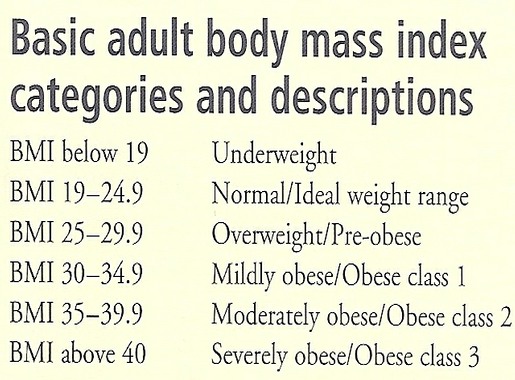 Body weight (mass) will remain static if the energy fuel (food) taken in by the body equals the fuel burned during daily activity.
Body weight (mass) will remain static if the energy fuel (food) taken in by the body equals the fuel burned during daily activity.
If the fuel taken in exceeds the fuel needed by the body for day to day activity then the body will store the excess fuel as fat stores for a more lean time!! This will cause a weight gain.
If the fuel taken in is not sufficient to supply the energy demand for the days activity the body will retrieve some of the energy previously stored as fat and burn it instead – this leads to weight loss.
In extreme circumstances the body will turn to using body protein to get energy to keep going but this is rare .
Metabolic Rate refers to the amount of fuel that our body burns even when at rest. Metabolic rate can vary. It will change slowly in response to a number of factors.
Activity level is an important determining factor. Increased physical exertion / activity will raise the base metabolic rate and the opposite happens with prolonged relative inactivity. Therefore to maintain weight (loss) one must maintain increased exercise levels or reduce food intake as appropriate.
Athletes in the off season, or during breaks in training due to injury, need to reduce their food / calorie intake
Muscle Energetic's
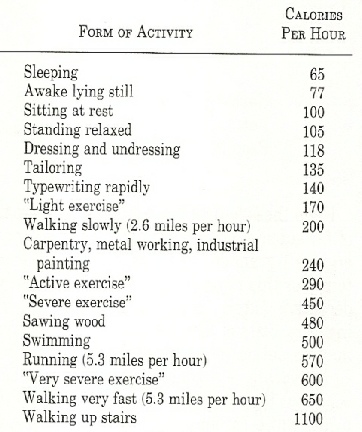

Body Weight
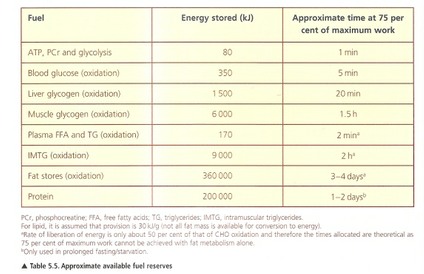
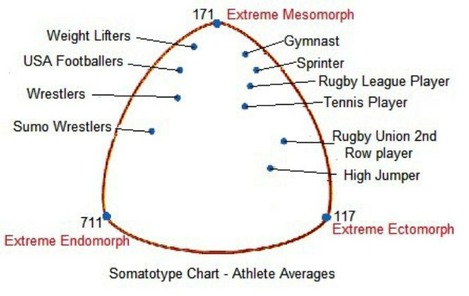 There are ideal body profiles for athletes in carious sports which reflect a recognised balance between strength, power, flexibility and endurance. Body mass and shape may be also be important factors for a sport.
There are ideal body profiles for athletes in carious sports which reflect a recognised balance between strength, power, flexibility and endurance. Body mass and shape may be also be important factors for a sport.
For the population at large BMI (Body Mass Index) gives a general indication. BMI compares the body mass (weight) against height. BMI gives a good indicator of a safe and healthy range of weight against any given height.
People often try to alter their body weight either up or down based on their personal goals or a perception of what is good for performance in their sport.
- Most people attempting to lose weight do so by trying to lose fat stores from the body.
- Those hoping to bulk up do so by adding muscle.
Power based sport require large masses of muscle – sprinters, rugby forwards, throwing sports, weightlifting/powerlifting – while some sports need low body fat – cycling, distance sports, rowing. Some sports compete by body weight category – boxing, judo, while others prefer low body weight - jockeys.
Ideal Body Weight (for Performance)
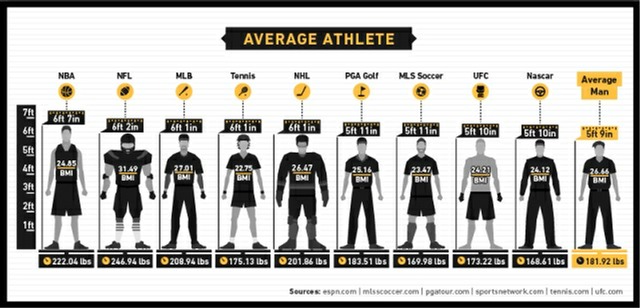
Many people have good intentions to get fit. There are a variety of types of ‘fitness’ which one may aim for.
The type + duration of training will depend on your ultimate goal. To achieve your goals you must be reasonable, practical and honest in your expectations given your personality and your individual circumstances.
The effort will need to be sustained over months rather than weeks, and will require significant personal time and effort, as well as lifestyle change.
Improving general fitness, weight loss, increased strength, improved endurance, improved flexibility or merely toning up will require different approaches to your fitness programme.
Physiological changes with increased fitness occur slowly, especially if they are to be maintained, and reverse if the training is not maintained.
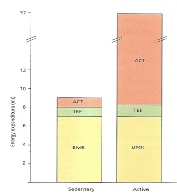 General fitness is often used to refer to cardiorespiratory fitness i.e. how effective is the body at absorbing O2 (or getting it into the body via the lungs), transporting it to the muscles (via the heart and blood vessels, extracting it from the blood into the muscle and then using it within the muscle to release energy.
General fitness is often used to refer to cardiorespiratory fitness i.e. how effective is the body at absorbing O2 (or getting it into the body via the lungs), transporting it to the muscles (via the heart and blood vessels, extracting it from the blood into the muscle and then using it within the muscle to release energy.
Working at an increased level of activity intensity will challenge all the above systems and cause them to adapt and become more effective and efficient.-i.e. having improved fitness.
It will take more effort to gain improvements in general fitness than it does to maintain levels of fitness.
You can retain any improvement even if you reduce the intensity, frequency and duration of training. However if you reduce the intensity, frequency and duration too much the improvement will be gradually lost.
Therefore the duration / distance covered / intensity of activity during training / exercise sessions are the variables we can change. By increasing either of these factors on a regular basis we can improve general fitness.
Weight loss should ideally be achieved through a combination of dietary change, exercise and use of weight loss aids where advisable (saunas etc).
- Rapid weight loss is often accompanied by loss of glycogen, water and lean muscle mass so while weight is indeed loss little or no body fat is lost. It is also associated with fatigue, low energy levels and poor recovery between training sessions, hence poor performance.
- A slow gradual loss of weight is more likely to permanently remove body fat. The change will only be maintained if the diet + lifestyle changes are made permanent – eating smaller portion meals, better balance within the diet, exercise regularly etc.
Guidelines for losing weight should include the following;
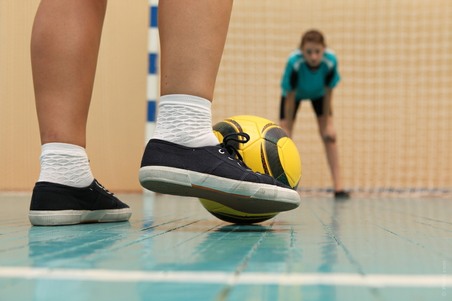 Have a plan individualised to you, to suit you and your lifestyle and personal circumstances – medical issues etc
Have a plan individualised to you, to suit you and your lifestyle and personal circumstances – medical issues etc- Keep it up: it is the medium to long term effort which is likely to produce the lifestyle changes to be most effective.
- Meet dietary needs from as wide a variety of foods from all the groups as possible
- Aim for 0.5-1.0Kg weight loss per week every week – not yo-yo up and down. Anything over this is likely to include fluid and lean muscle loss.
- Monitor progress regularly over longer rather than shorter term (weekly or fortnightly) and record results to see progress. Improvements that are likely to be maintained will be achieved slowly over months rather than weeks – hence the need for lifestyle change. It must become habit to eat smaller, better meals and to exercise more. Treats need to be earned!!
- Follow well formulated programmes by suitably qualified people that are appropriate for your circumstances. Focus on small meaningful changes and allow yourself a reward from time to time – if you have earned it!!.
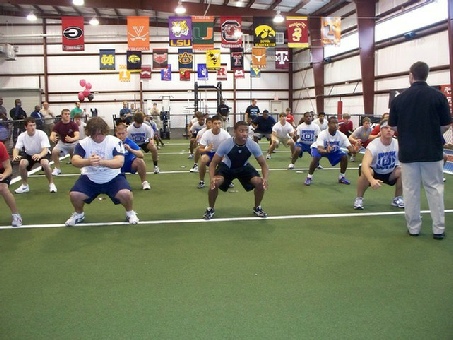 Increase total physical activity: increase the duration, distance or intensity of your exercise sessions.
Increase total physical activity: increase the duration, distance or intensity of your exercise sessions.- Use exercise which uses as many of the muscles in the body as possible, especially the bigger muscle groups of the legs and arms. The more muscle working the more fuel burned! Brisk walking, running and swimming are among the best forms of exercises but cycling, dancing and rowing are also good.
- Reduce calorie intake by either substitution or reduction of foods ingested.
- Fat intake in the diet should be limited; avoid ‘hidden’ fats like fried foods, crisps, chocolate, fatty meat.
- Dietary Fibre, often lacking, if used to replace fatty foods can greatly increase the amount one can eat while still losing weight. These foods also tend to provide other health benefits and you are less likely to be hungry again soon after
- Plan your eating and consider the timing of your meals: spread the total daily intake evenly through the day. Provide appropriate ‘fuel’ prior to training + for recovery afterwards. Avoid big meals prior to periods of rest / inactivity by timing your meals correctly.
- Improving kitchen skills (!) is an important part of learning to eat better and more healthily
- Managing your fluid intake is important, especially if dehydration is a possibility. Dehydration will impair performance. Soft drinks and alcohol provide little benefit / fuel for fitness so are best limited as much as possible. Sports energy drinks are generally not necessary unless regular prolonged high intensity exercise is undertaken (marathon type events of 2-3 hours +) – plain water is perfectly adequate and has no added calories!
- Sports energy drinks and bars are very high in calories and should be avoided except to provide rapid energy replenishment after prolonged efforts. You need to be using them in a timely manner. 1 bottle of sports drink to every 2-3 bottles of water is a good ration for good hydration with some energy supply on long events.
- If your resolve breaks don’t worry simply gather yourself and get back on programme as quickly as possible. Changes in your metabolic system occur so an occasional brief slip up will not cause too much harm.
- Allow for times when you may veer off programme - Christmas, weddings, your birthday etc - and enjoy them. Use as much restraint as possible and get back on track as soon as possible.
General Fitness + Weight Loss
Guidance for Weight Loss Programme
General Fitness
BMR = Basal Metabolic Rate
TEF = Thermic Effect of Food
ACT = Activity
Most people have sufficient strength for every day life without doing specific strength training.
Initial strength gains in the first weeks of strength training are due to increased activation of the neuromuscular system.
Doing weight or resistance training will increase the activation of the trained muscles and will ‘tone’ them up. This may be associated with improved body definition and shape (in conjunction with fat loss). Continued resistance training which overloads the muscles will eventually lead to hypertrophy - or an increase in the size of the trained muscles. It is specific to the trained muscle only.
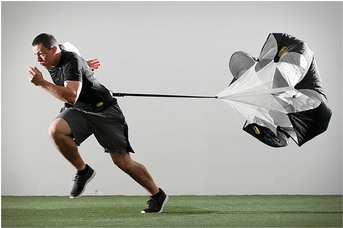
The following changes occur with Strength Training
1. Increased glycogen and protein storage within the muscles
2. Increased vascularisation / blood flow in the muscle
3. Increased biochemical activity among the enzymes that release the energy from the fuel stores
in the muscle
4. Increased myofibrils / muscle fibres in action
5. Recruitment of neighbouring motor units.
There are three types of this training
Isotonic - where the resistance / load remains constant but speed can be varied
Isokinetic - where the speed remains constant but the load / resistance can vary
Isometric - exercise against immovable object but muscle remains at same length.
Strength Resistance Training
Some people, especially young sportspeople are encouraged to gain weight in order to perform optimally in their sport. Diet alone will not increase muscle mass. To increase muscle mass requires combining correct diet (protein along with appropriate carbohydrate intake) with suitable strength training, rest + recovery. A high protein intake of 150-200% of the normal recommended daily intake (RDI) is often recommended for those attempting to increase body weight. For most people sufficient dietary protein can be provided from within a normal balanced diet.
Gaining Body Weight Safely
The following are some points worth noting
- High Protein Intake: Diet alone will not increase muscle mass. Use of powdered protein drinks are proposed as an essential component of bulking up / increasing the body’s muscle mass. Many of the protein drinks on the market are based on skimmed milk powder with added vitamins and minerals. Lot fat milk would provide sufficient protein for many peoples needs.
- Many people ingest excessive amounts of protein for the type of training they are doing. There is no evidence of any benefit from this excessive intake and the excess is likely to get stored as fat!
- Excessive protein intake may indirectly inhibit intake of appropriate amounts of carbohydrate. This could lead to protein being used as a source of energy which is less than optimal.
- Excessive protein intake can cause increased risk of dehydration, calcium loss and conditions such as gout.
- Amino Acid Supplementation may be used in the hope of stimulating human growth hormone, and hence increasing muscle mass. There is no evidence for this nor any any correlation with increasing muscle strength.
- Use of substances banned in sports (anabolic steroids, hormone based substances) may help but on their own have no benefit in increasing strength or in bulking up. There are significant health risks associated with their use and they are widely banned from use in sports.
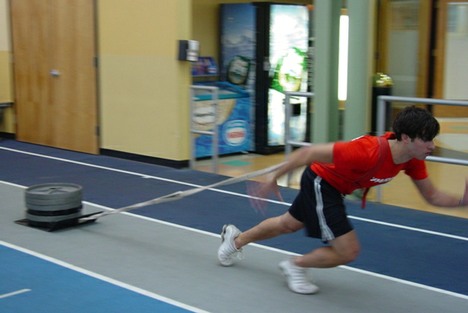
This refers to the muscles rate of producing work. It equates with explosive type strengthening exercises. It is most suitable to those who compete in sport where an explosive movement is an inherent component in the sport activity. This may take the form of fast speed exercises, fast functional exercises or plyometrics.
Muscle Power Training
This training refers to activities which train the whole neurological control mechanisms of movement. It can include what is called functional training.
It is important in the development of basic motor skills. It includes learning the basic components of the sporting activity / skill. Once each component movement is mastered they can all be put together. It develops the correct ‘pattern’ of movement. Speed and power can be added later as required. Maintaining control of posture and the required movement is paramount.
I.e. throwing athletes need to slowly develop the range and power of movement, with good technique, in order to protect the shoulder area.
Normal neurological control depends on intact sensory (incoming) signals to the brain from the peripheral joints and muscles, which it then processes before producing the required motor signals to the muscles to produce the required response.
If a problem develops in either the sensory or the motor pathways the produced movements may be less than optimal. A sprained ankle demonstrates this as the injury interferes with the sensory signals to the brain. The person may be unaware the ankle is turning over and thus cannot react in time to prevent it recurring. With appropriate retraining the motor response can be improved or corrected and further injury avoided.
Progression of this training includes increasing the complexity if the activity. I.e. progress form walking to jogging, to running, to running with a ball, to running in and out of cones with ball, to running and kicking ball at a target, to tackling against an opponent with ball.
Neuromuscular Control Training
Balance / Proprioceptive Training
This training of known as Aerobic training aims to increase the body aerobic capacity i.e. the ability to use O2 to release energy from glycogen. It involves the muscles sustaining repeated contractions over prolonged periods. Endurance training should be done alongside strength training.
To improve endurance it is necessary to improve the aerobic energy pathways for fuelling the muscle i.e. improving the oxidative enzyme efficiency + capacity of the muscle fibres – particularly the slow twitch fibres. This is measured by VO2max - the maximal rate at which O2 can be consumed. This increases with training. It can be indirectly measured by using Heart Rate (HR) at given exercise intensities.
Aerobic Training effects are achieved with sub maximal training at an intensity which produces 70-85% of maximal HR (220 - Age). Thus for a 50 year old aerobic training is achieved when HR is between 70-85% of 170 i.e. HR = 120 - 145.
This is achieved with high repetition muscle contraction under low loading i.e. by slow steady running or cycling, swimming, circuit training. The changes that occur include:
- Increased cell mitochondria numbers + activity
- Increased muscle glycogen
- Increased use of free fatty acids (FFAs)
- Increased vascularity
- Cardiovascular effects including
- Lower Heart rate
- Lower blood pressure
- Increased stroke rate and volume
Increased endurance occurs only in the muscles used in the exercises so is specific to the activity and the muscles used and there is no cross benefit to other muscle groups.
Muscle Endurance Training
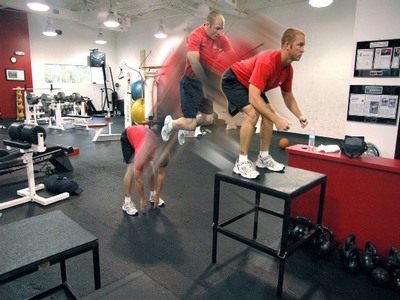
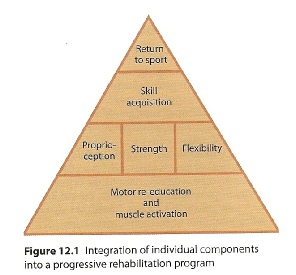
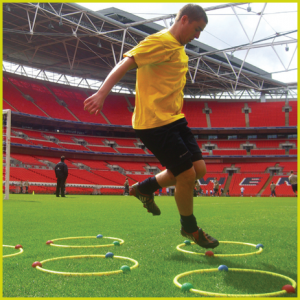
Flexibility training is more than simple stretching. The issue of stretching has been controversial.
Stretching will impact on both the muscles and the ligaments supporting the joints.
Excessive flexibility can be problematic – joints that are too flexible (hypermobility) are at higher risk of injury and excessively stretched muscle may become  weaker and less effective in producing or controlling movements.
weaker and less effective in producing or controlling movements.
Potential benefits include
- Reduced muscle soreness
- Reduced muscle tension / tone = increased relaxation
- Reduced muscle resistance to opposite movement
- Improved muscle extensibility
- Increased joint range of movements
- Improved circulation
- Reduced adhesion between layers of tissues (following injury)
Flexibility Training should take account of the following:
- Be preceded by a short period of warm up with steady exercise
- Warm muscles stretch more easily – keep covered during warm up to avoid exposure to cold
- Correct posture and technique fare important for effective stretching movements
- Avoid excessive speed when applying a stretch - muscles have a protective mechanism called the stretch reflex which causes the muscle to contract against a sudden stretching force.
- Dynamic stretches should be done prior to training sessions and Static stretches should be emphasised after training.
- For static stretches the stretch should be applied slowly and held for > 15 secs. To increase the length of the muscle the hold needs to be even longer.
- Exhaling (breathing out) will assist with stretching. Therefore controlled breathing is important element of success in flexibility training.
- For dynamic stretches slowly build up the extent of / range of movement while gradually increasing speed of movement up to near normal sporting speeds.
- To develop flexibility one must work on stretching more frequently, for longer and pushing to the end of available range of movement and beyond.
- Flexibility can be maintained by less intense and frequent stretching.
Avoid becoming excessively flexibility beyond what is normal movement for joints or muscles – this would lead to instability around the joints and reduces dramatically the amount of force that an over stretched muscle can exert. Thus dynamic > static stretching is preferred prior to training or competing.
Ballistic / bouncing type movements in a stretch is normally not recommended unless it is a movements appropriate + specific to that sporting activity. It should always be performed with care.
Flexibility Training
This refers to training of the cardiovascular system i.e. the system of getting O2 from the lungs to the muscles where it can be used to extract energy from the food fuel sources there (metabolism), and the subsequent transport of the by products (CO2, lactate + water) away from the muscles.
The system can be trained to adapt so that more O2 is taken into the bloodstream (deeper and more rapid breaths), so more oxygenated blood is transported from the lungs to the muscles (deeper and more rapid beating of the heart, opening up more blood vessels). Afterwards the system can remove the by products of energy extraction (water and lactate) as quickly as possible.
Heart Rate (HR) is often used as an indicator of fitness + of the intensity of the training being done.
Training normally uses HR as measure to gradually build up or maintain a given intensity of training. HR based training begins with low intensity / low load training but can include anaerobic and aerobic interval training.
Cross training in different sports is often used for this type of training to maintain interest and variety in training.
Cardiovascular Training
Speed is largely inherited but can be improved by improving strength and power, therefore speed training must be accompanied by resistance and power training. Increasing stride length & cadence helps increase ground coverage.
Running drills help and technique work will also help to develop speed.
Agility and reflexive responses are also largely inherited characteristics. However it does improve with training. The exercises are sport specific if possible and reflect the movement patterns used within a sport.
Speed & Agility Training

